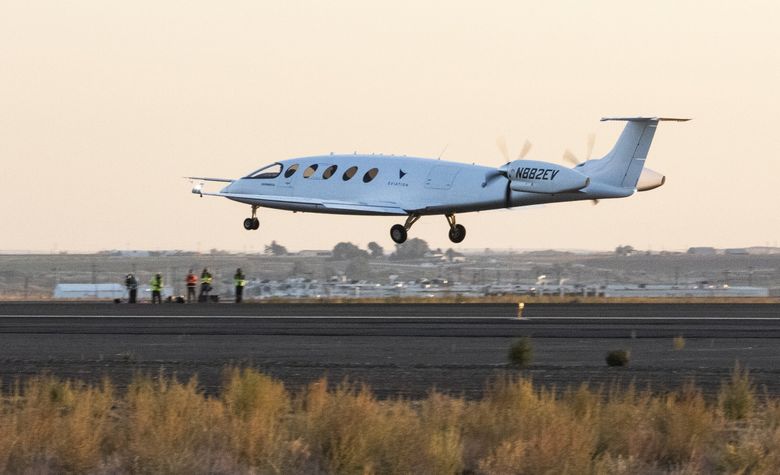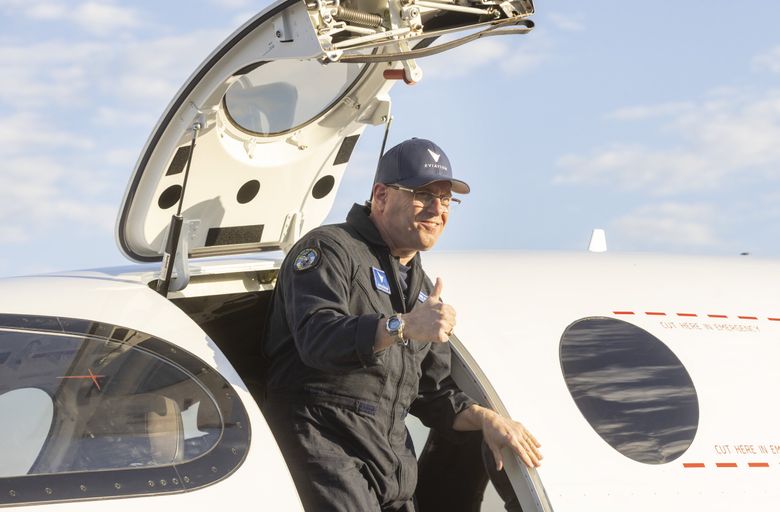MOSES LAKE — After months of delay, a sleek all-electric airplane prototype buzzed like a hornet at the end of the runway, then sped off and lifted into the sky above Central Washington on its first flight at 7:10 a.m. Tuesday.
The plane took two wide turns around the airfield, climbing to 3,500 feet. As it passed directly overhead, people on the ground heard a whirring buzz, a fluttering of air from the propellers at the rear of the fuselage.
The plane landed safely just 8 minutes later. As it taxied in to the terminal, it gave a couple more loud buzzes when the pilot revved the motors.
The plane, built to carry nine passengers and one or two pilots, was designed and built by Arlington-based startup Eviation to demonstrate the potential for an electric commercial commuter aircraft flying a few hundred miles between cities at an altitude of around 15,000 feet.
It’s powered by just over 21,500 small Tesla-style battery cells that, at just over 4 tons, make up fully half the weight of the carbon composite airframe.
They drive electric motors designed and built by MagniX in Everett.
The technology is pioneering and puts this region at the forefront of efforts to develop a zero-emission, sustainable era in aviation. But whether it can deliver the economic returns necessary to become a commonplace mode of air travel remains highly uncertain.
In an interview in Moses Lake on the eve of first flight, Eviation CEO Greg Davis conceded that the prototype that took off Tuesday is not the design the company will build later.
He said Eviation needs still-to-be-developed advances in battery technology to make its planes commercially viable.
“Are the batteries on the prototype aircraft capable of propelling the certification aircraft, capable of providing sufficient energy? The answer is no, absolutely not,” Davis said.
In an interview in February, Davis had spoken of pushing hard to certify a production model of the airplane for passenger service in 2024. On Monday, he said that goal is probably five years away.
On Tuesday morning though, such worrying details were momentarily set aside to savor a notable milestone in the development of this electric airplane, whimsically named Alice.
“What we’ve just done is made aviation history,” said Davis. “This is about changing the way that we fly. It’s about connecting communities in a sustainable way.”
“It’s really ushering in a new era of aviation,” Davis added. “This is the first radical change in aerospace propulsion technology, since we went from the Super Constellation to the 707, from the piston engine to the jet engine, and now to the electric motor.”
After emerging from the cockpit, Eviation test pilot Steve Crane, 55, said Alice “flew and handled wonderfully.”
“It’s beautiful,” he said. “The team did a great job, built a great airplane. It’s a fast airplane, very responsive. I couldn’t be happier.”
Inside the cockpit, he said he didn’t hear the engines.
“I hear all the other things. Hydraulic pumps. I hear the propellers. But I can’t hear the engines. They’re silent,” Crane said.
plaining the brevity of the test flight, Crane said “What we wanted to do is check for pitch authority, the stability of the aircraft and bring it in for a safe landing.”
“You just take baby steps, one step at a time,” he added.
Designed by engineers in Washington state and Israel, the airplane’s name is inspired by Lewis Carroll’s magical tales of Alice’s adventures in Wonderland.
Just a prototype
The first all-electric flight in North America was made by a retrofitted DHC-2 de Havilland Beaver seaplane operated by Harbour Air of Vancouver, B.C., in December 2019. It too was driven by MagniX motors. That plane is currently being flight tested and is not yet certified to carry passengers.
If the Federal Aviation Administration certifies Alice to carry passengers, it could potentially become the first all-new, all-electric commercial airplane.
However, that vision is farther off than Tuesday’s flight might suggest.
When Boeing has a first flight, that’s the start of the certification process. Boeing immediately begins conducting tests and collecting data to present to the FAA as proof that its plane is airworthy.
That’s not the case for this Alice flight.
Eviation’s prototype is “what’s being used to prove the concept,” said Davis. “At this point, we’re not actually pursuing certification.”
“What’s next is actually producing an airplane for the marketplace,” Davis said. “This is an amazing achievement, but this is just a milestone in terms of where we’re headed.”
“We’ve got several weeks to go through and review the data from this flight,” he said. “We’ve downloaded terabytes of data. … We’re going to figure out what we need to tweak on the aircraft in order to improve its performance and then fly it again.”
Eventually, Eviation plans three production variants — a nine-passenger configuration, a cargo version, and an executive model with a more luxurious cabin — that will incorporate significant design changes from the prototype.
Aside from totally different batteries, the production models will have pressurized cabins, unlike the prototype.
They’ll also have a different configuration of the movable flaps on the wings, Davis said.
And in addition to the two battery packs the prototype carries in the fuselage belly under the passenger cabin, the production models will have a third pack at the back of the plane.
Flight tests as part of FAA certification can begin only when a production model is ready to fly.
Davis anticipates about three more years of development before flight tests begin, then about another two years for flight tests and certification — pushing entry into service out until at least 2027.
For the engineering and manufacturing team at Eviation, it’s been slow progress toward an exciting goal.
Lance Bakki, Eviation’s operations manager in Arlington who formerly served as a senior manager at Boeing, said more than a third of his team is ex-Boeing.
Whereas work at Boeing tends to be siloed and narrowly specialized, he said, the scale of Eviation offers the chance to “use all your skills” in a variety of work.
“It’s an opportunity to build the future of aviation,” said Bakki. “It’s revolutionary.”
Back in February, after setbacks and delays last year, Alice had begun taxi tests on the ground and Davis said then he anticipated the first flight within weeks.
At that time, Eviation had 110 employees and he projected hiring 60 more this year.
Since then, reality has set in and management has slowed the schedule substantially.
Seven months passed before the plane finally lifted off. And rather than hiring aggressively, in the interim Eviation has cut jobs: It now has just 90 employees.
Davis said it was necessary to slow things down to fit the expected schedule for when more advanced batteries would likely be available and to be prudent “from a cost and cash consumption perspective.”
Eviation currently has just two job openings, one of which is for an aircraft chief engineer to “manage and lead the Alice aircraft design and performance definition.”
Tuesday was clearly a first milestone with many miles still to go.
Competition in zero-emission flight
There’s no practical way to design a battery-powered large airplane of the size of a Boeing jet. The batteries required would be too heavy for flight.
Alice represents a vision of the future for smaller-scale aviation.
In the race to decarbonize air transportation, the only certified all-electric airplane in the world today is a tiny two-seater, the Velis Electro, built in Slovenia by Pipistrel.
That company was acquired in April by Wichita, Kansas-based Textron, the maker of Cessna, Beechcraft and other small aircraft.
Then there are multiple startups — including Joby, Wisk and Vertical Aerospace — working to develop short-range, all-electric urban taxis.
The Alice commuter plane, flying short intercity routes, is a third possibility for the electric aircraft future that has also attracted several competitors.
Among the most promising, Italian airplane maker Tecnam is developing the P-Volt, an all-electric version of its existing nine-passenger, piston-powered P2012 model, and aims for a first flight by 2026.
In reaching first flight, even if only a prototype, Eviation’s all-electric technology is ahead of such competition.
The next step “is about getting it certified, getting it produced, the sourcing, supply chain, getting our processes in place,” Davis said. “It’s the grit that you need to have in order to be an aircraft manufacturer, to demonstrate that the product is going to be safe and reliable every time.”
The Alice prototype was assembled in a hangar in Arlington from large pieces manufactured by various suppliers.
The fuselage was made in France by Multiplast, part of the Carboman Group, specializing in composite materials.
GKN made the wings in Filton, England.
Davis said Eviation would like to bring the manufacturing to the U.S. for production aircraft. He is discussing options with the partners and “looking for alternatives for supply.”
“We are going to use a supply chain and we’re trying to make it as domestic as possible, given the lessons learned over the past two years of supply chain disruption,” Davis said.
“I don’t want to be a fuselage manufacturer. There’s people who specialize in doing this,” he said.
Instead, Davis said Eviation will focus on designing aircraft to be electrically powered, integrating the batteries with the flight system and assembling the aircraft.
Early in the development of Alice, Eviation founder and previous CEO Omer Bar-Yohay mentioned a sale price of $4 million per airplane. Davis declined to disclose the aircraft’s current price.
The market economics challenge
Whether Alice can succeed economically is a separate and difficult question.
A detailed analysis last year by Courtney Miller of the aviation news site The Air Current concluded that the market for small, regional all-electric planes is small and that they won’t be economically competitive against similar-sized gas-powered turboprops.
While the all-electric planes are cheaper on fuel and engine maintenance, Miller said those savings are outweighed by the high costs of purchasing the electric airplanes and of replacing their expensive batteries after 800 to 1,000 flights.
His analysis forecast that a hybrid electric technology with more range would be more viable for small regional airplanes.
A recent about-turn by another startup, Heart Aerospace of Sweden, seems to confirm that judgment.
Heart had been developing a 19-seat all-electric plane with commitments to buy from United and other airlines. But this month it announced the scrapping of that initial plan in favor of a 30-passenger hybrid-electric plane, with its battery power backed up by two gas-powered turbine generators to provide extra reserve range.
Davis insists that Heart’s original 19-seater was too large for an all-electric flight and that Alice’s nine-passenger model is the commercial “sweet spot.”
Flying more than nine passengers requires a second pilot, increasing the cost dramatically.
Eviation insists against all naysayers that its plane will create new markets.
It hopes to sell these planes to operators flying passenger routes of between 200 and 300 miles — potentially filling in the gaps of the current major airline networks with direct service between smaller airports.
“Every airport of any size, any municipal airport, becomes viable,” said Davis.
Out of Seattle, he said, Alice could be flying to “Vancouver, Victoria, Bellingham, Portland, Walla Walla, Yakima, Moses Lake, Spokane.”
Alice’s cited maximum range on a single charge is 440 miles, but that is conditional.
“It’s gonna depend,” Davis said. “The route actually matters. If you have to climb to avoid terrain, if you’ve got weather, winds, there’s going to be factors that will play into what the range is.”
Though making it from Seattle to Spokane without stopping to recharge might be pushing it, Davis said, “I think we could do that.”
And he cites evidence of a nascent market.
In April, Massachusetts-based Cape Air, one of the largest commuter airlines in the United States, said it will buy 75 Alice aircraft. This month, Miami-based Global Crossing Airlines Group said it will take 50 for charter flights in Florida and the Caribbean.
Those deals are merely “letters of intent” — agreements to buy the airplane in the future provided it gets certified. No upfront financial commitment was disclosed.
German freight carrier DHL said last year it will take a dozen of the cargo variant, but again did not disclose any financial commitment.
Still, that interest is enough for Davis to predict that Alice, eventually, will be successful.
In February, previous Eviation CEO Bar-Yohay suggested that production of the Alice airplane could rise as high as “many hundreds, if not a thousand airplanes per year in a reasonable time.”
Bar-Yohay was ousted just days after that projection, replaced by Davis.
While Davis said Bar-Yohay’s production figure is “not crazy,” more realistically, he said gradually increasing production to “100 aircraft a year” is the initial target.
Making the battery system safe
The integration of the batteries with the aircraft systems is Alice’s key technology challenge and its biggest potential vulnerability.
The batteries drive electric motors developed by Everett-based startup MagniX that turn the propellers.
However, as Boeing found out on its 787 Dreamliner, lithium ion batteries can fail dramatically.
In 2013, the main battery on the 787, which was not providing flight power but merely running some electrical systems, smoldered in flight and caused the fleet to be grounded for nearly four months.
There have been multiple incidents of Tesla cars catching fire due to battery failures.
The real danger is one battery cell releasing intense heat and gases that spread the damage to adjacent cells — creating what is called a “thermal runaway.”
Designing a battery pack to prevent that is critical.
“We monitor each of the cells individually. We have a sensor that keeps track of the cell voltage,” said Davis. “The computer will be able to identify that a cell is behaving improperly. Then it can take that subpack offline. It will tell it to stop.”
Each of the subpacks will theoretically contain a cell if it’s running away. But in case such a cell failure is not contained, Alice has two “burst disks” on either side of the bottom of the fuselage, through which hot gases will vent to the outside away from the passenger cabin.
“You would have plenty of time to land and evacuate the aircraft,” Davis said.
He added that in case of a crash landing onto the belly of the airplane, where the battery packs are located, there is structural reinforcement and a crumple zone to protect the battery cells.
All of this advance design work must now be modified to integrate what may be entirely different batteries that can provide more energy — batteries not yet invented.
“We look like we’re going to have some fairly favorable battery technology available to us in five years,” said Davis.
Whenever the new batteries are integrated, all the safety elements Eviation has wrapped around them will have to be thoroughly tested and vetted by the FAA before Alice can be certified.
Another hurdle to getting certified is that there is no international agreement between the FAA of the U.S. and its European equivalent EASA on what tests electric aircraft manufacturers will have to do to prove their battery systems are safe.
There’s no telling when such regulatory agreement will happen.
In the meantime, there are still at least five years of development costs ahead, likely amounting to several billion dollars.
Both Eviation and electric motor maker MagniX are part of the Clermont Group, a collection of investment companies funded by New Zealand-born, Singapore-based billionaire Richard Chandler.
At Moses Lake Tuesday, Chandler said he was “super excited” at the first flight and seemed unconcerned about the cash requirements ahead over the next five years.
“There’s tremendous commitment on behalf of all the shareholders to see the program through to completion and entry into service,” Chandler said in an interview after the flight.
“As we go along, we’ll hit both technical milestones and financial milestones,” he said. “Today was a really important milestone in seeing that happen.”
“I’m really excited for the future of aviation, and to be able to provide a carbon-zero solution to regional transportation in the next five years,” he said. “It’s a revolutionary product.”
Also attending the event, Rep. Rick Larsen (D-Everett), who represents Arlington and is chair of the U.S. House Aviation Subcommittee, called Alice’s first flight “historic.”
He said both Congress and the FAA need to prepare now for new laws and regulations to facilitate “all this innovation and technology that is coming into aerospace.”
To suggest where the Alice program stands now and what’s to come, Davis compared Tuesday’s first flight to “Alan Shepard, going into space.”
“The mission that we have in front of us … it’s the whole space program. It’s the Apollo mission,” he added.
Shepard in 1961 became the first American to go to space, in a 15-minute up-and-down flight. In 1969, the Apollo astronauts landed on the moon. It was an astonishing progress in just eight years.
Eviation now hopes to bring its Alice project to fruition in five.
“We’re on a tighter time frame,” Davis acknowledged.



